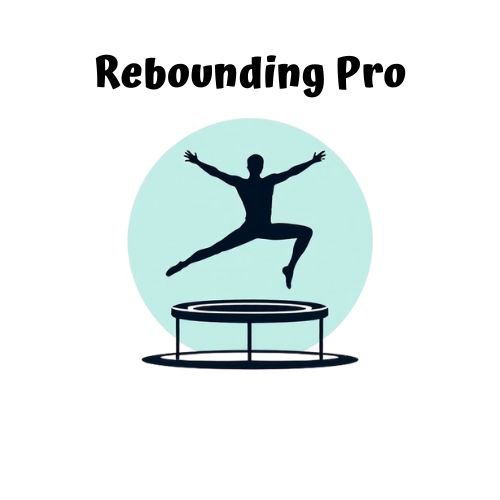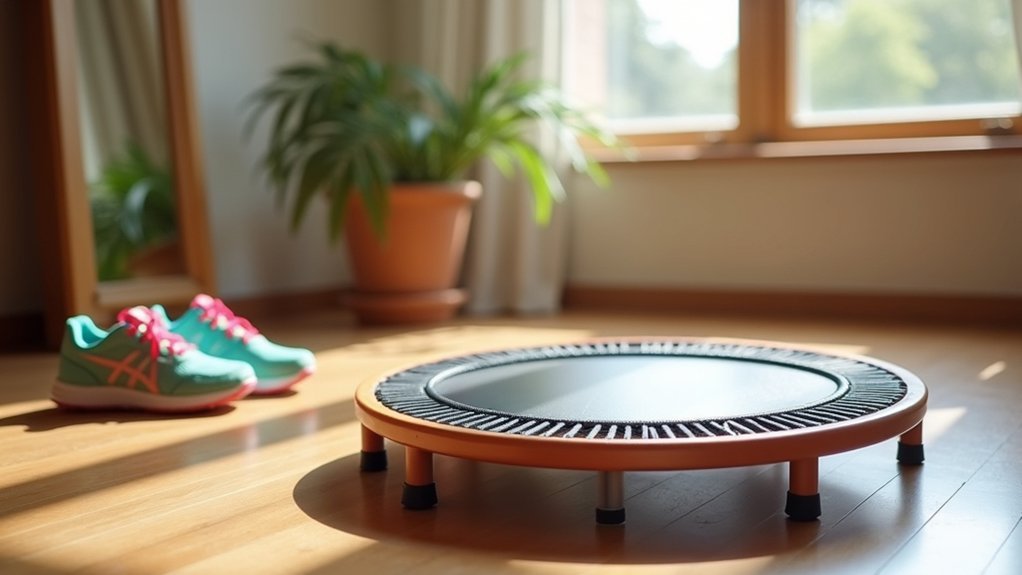Mini trampolines absorb over 80% of joint impact, protecting your hips while still providing bone-strengthening benefits. You’ll experience gentler loading on cartilage and ligaments compared to hard-surface exercises, making them ideal for those with arthritis or joint concerns. The bouncing motion activates hip stabilizers, improves balance, and enhances circulation to nourish joints. The micro-adjustments required during rebounding strengthen your core and hip muscles simultaneously. Discover how this low-impact workout transforms weak spots into power centers.
The Shocking Truth About Impact Absorption and Hip Protection

While many fitness enthusiasts focus solely on high-intensity workouts, they’re often overlooking a critical component of joint health. Mini trampolines provide remarkable protection for your hips through superior impact absorption.
These rebounders absorb over 80% of joint impact that would otherwise stress your hips. Unlike running, which concentrates force on specific joints, trampolines distribute G-forces evenly across your body. The pliable surface dramatically reduces peak vertical ground reaction forces compared to hard surfaces.
Mini trampolines protect your hips by absorbing most impact forces and distributing them evenly, unlike hard-surface activities that concentrate stress on specific joints.
You’ll experience decreased jarring motions that protect hip joints from repetitive strain injuries common in high-impact activities. The soft surface dampens shock, minimizing hip flexion angle changes and preventing compensatory stiffness in your lower extremities. Choosing rebounders with bungee cords instead of springs provides an even smoother and safer experience for your hip joints.
This makes mini trampolines particularly valuable if you have arthritis, previous injuries, or want to preserve long-term hip health.
Building Stronger Hips: How Rebounding Enhances Bone Density
When it comes to combating age-related bone loss, mini trampolines offer a powerful yet gentle solution for maintaining hip health.
Research shows that regular rebounding considerably increases bone density, particularly in vulnerable areas like your hips and spine.
Studies involving postmenopausal women found that just 12 weeks of trampoline workouts improved overall hip health and bone density.
Unlike high-impact exercises that stress your joints, rebounding provides the bone-strengthening benefits without the harsh impact.
You’ll also strengthen the muscles surrounding your hips, creating a supportive framework that further protects your bones.
This combination of muscle engagement and bone stimulation creates the perfect environment for hip health improvement.
Competitive trampolinists consistently demonstrate superior bone strength compared to those who don’t practice this exercise form.
The low-impact nature makes mini trampolines especially valuable if you’re already experiencing bone fragility or osteopenia, providing safe exercise that builds strength gradually.
Balance Your Way to Better Hip Stability Through Rebounding

Balance isn’t just a matter of staying upright—it’s the foundation of hip health and overall mobility. When you bounce on a mini trampoline, you’re forcing your body to make continuous micro-adjustments that activate core muscles and enhance your proprioceptive system.
Balance requires continuous adaptation—the mini trampoline trains your body to respond instinctively while protecting your joints.
The unstable surface challenges your vestibular system while simultaneously engaging your hip stabilizers—including the essential gluteus medius and minimus. These muscles work together to support your pelvis during daily activities.
What’s remarkable is that you’re strengthening these systems with 83% less impact than walking. This gentle yet effective training improves both static and dynamic balance, with studies showing a 35% improvement in balance recovery after just 14 weeks.
For those concerned about falls or hip stability, rebounding offers a safe way to build confidence and functional mobility. The low-to-the-ground design of mini-trampolines provides excellent stability while still challenging your balance systems effectively.
Hip Muscle Activation Patterns During Mini Trampoline Workouts
Mini trampolines create unique muscle activation patterns in your hips during workouts, triggering coordinated responses that you simply can’t replicate with traditional exercises.
The elastic surface demands rapid stretch-shortening cycles in your hip muscles, enhancing motor unit recruitment through quick loading and powerful contractions.
When you bounce, your body experiences:
- Co-activation of antagonist hip muscles (flexors and extensors) that stabilize your pelvis and maintain balance
- Enhanced proprioceptive feedback that improves coordination between muscle groups
- Synchronized activation patterns during reactive jumps that increase neuromuscular efficiency
Different movements target specific muscle groups – bounce downs activate your glutes and hamstrings, staggered stances recruit adductors and stabilizers, while twisting motions engage your external hip rotators and obliques. The low-impact nature of rebounding significantly reduces joint stress while still providing effective muscle engagement for hip health.
Comparing Joint Stress: Mini Trampolines vs. Traditional Exercises

Unlike high-impact exercises that hammer your joints, mini trampolines offer a revolutionary approach to fitness that considerably reduces stress on your hip joints while delivering comparable benefits.
The elastic surface absorbs approximately 83% of impact compared to walking on pavement, providing a controlled deceleration that considerably lessens shear forces on your hips.
Research shows mini trampolines absorb 83% of impact, transforming high-impact activity into joint-friendly, effective exercise for your hips.
You’ll experience gentler loading on cartilage and ligaments, making rebounding ideal if you have arthritis or joint sensitivity.
The efficiency is remarkable too—mini trampoline workouts are 68% more energy-efficient than running, requiring less cardiovascular strain for equivalent aerobic results.
While traditional exercises like jogging impose greater impact forces on your lower limbs, rebounding strengthens your hip muscles with minimal joint stress, improving balance and stability without the cumulative trauma risk.
This low-impact exercise is particularly beneficial for individuals over 50 who need to maintain bone density and muscle strength while protecting their joints.
Rebounding for Seniors: Age-Specific Hip Health Benefits
As we age, maintaining hip health becomes particularly essential, and mini trampolines offer a perfect solution for seniors seeking gentle yet effective exercise.
Rebounding strengthens the muscles surrounding your hip joints, enhancing stability while minimizing impact that could aggravate arthritis or joint pain.
Mini trampolines provide age-appropriate benefits that specifically address senior health concerns:
- Enhanced balance and coordination – critical factors in preventing falls that often result in devastating hip fractures
- Improved circulation – delivers crucial nutrients to joint tissues while reducing inflammation and pain. The gentle bouncing motion stimulates blood flow to otherwise stagnant areas, helping alleviate joint discomfort.
- Increased bone density – helps combat age-related bone loss that makes hips vulnerable to fracture
The accessibility of rebounding makes it ideal for year-round indoor use, with stability bars offering additional security for those with balance concerns.
Recovery and Rehabilitation: Using Mini Trampolines After Hip Injuries
When recovering from hip injuries, mini trampolines can serve as valuable rehabilitation tools that bridge the gap between clinical therapy and returning to normal activities. The elastic surface absorbs impact, protecting your healing hip joints while you strengthen surrounding muscles.
You’ll find these rebounders particularly effective during progressive rehabilitation. The unstable surface helps stimulate the lymphatic system, aiding your body’s natural detoxification process during recovery. They prevent muscle atrophy and allow for controlled weight-bearing exercises that won’t stress your recovering hip. The unstable surface improves your balance and proprioception, reducing fall risks during recovery.
Unlike traditional rehab methods, mini trampolines offer engaging, motivating sessions that you can easily adapt as your strength improves. They’re cost-effective and space-efficient, making them practical for home rehabilitation between therapy appointments.
This low-impact approach creates an efficient recovery pathway back to daily activities.
The Neurological Connection: How Bouncing Improves Hip Coordination
The neurological benefits of mini trampolines extend far beyond simple exercise. When you bounce, you’re creating a powerful feedback loop between your brain and body that specifically enhances hip coordination. Your vestibular system constantly adjusts to gravitational changes, improving your proprioceptive awareness.
This neurological engagement translates to practical benefits:
- Dynamic stability improvement – You’ll develop faster recovery mechanisms during potential falls by enhancing your hip moment generation.
- Enhanced spatial awareness – The unstable surface trains your brain to better recognize hip positioning in space.
- Neuromotor development – Your brain creates new pathways that improve coordination between your core, hips, and lower extremities. Regular mini-trampoline exercise can improve balance by approximately 35% after 14 weeks of consistent training.
This neurological training helps you maintain balance during daily activities while reducing fall risk long-term.
Circulation Boosters: Mini Trampolines’ Effect on Hip Joint Nourishment
Mini trampolines offer more than coordination benefits—they’re powerful circulation boosters for your hip joints. The repetitive bouncing motion stimulates synovial fluid production, enhancing lubrication and reducing friction where your hip bones meet.
When you rebound, you’re activating multiple circulatory systems simultaneously. The gentle up-and-down movement increases blood flow through your hip’s microvascular network without harmful compression, delivering oxygen-rich blood to tissues that need repair. The Boogie Bounce rebounder’s patented T-bar handle provides extra stability during these circulation-enhancing movements.
Meanwhile, vertical acceleration forces pump your lymphatic system, removing inflammatory toxins from the hip region.
Even your bones benefit as the controlled impact stimulates osteoblast activity, increasing bone density—especially valuable if you’re concerned about osteoporosis.
Just 60 minutes twice weekly can considerably improve these circulation-related metrics, providing essential nourishment to your hip joints.
Creating a Progressive Hip-Strengthening Routine on Your Rebounder
Your trampoline journey begins with fundamental exercises like single-leg balances before advancing to more challenging moves such as single-leg squats and hip thrusts.
Progressive workouts gradually strengthen your hip abductors, flexors, and external rotators—key stabilizing muscles that protect your hip joints from injury.
You’ll notice improved stability with each session as these targeted exercises transform weak spots into power centers for better mobility and reduced pain. The portable design of a mini trampoline allows for convenient placement in your home, making hip exercises easily accessible for consistent practice.
Beginner To Advanced Progression
Building a progressive hip-strengthening routine on your rebounder allows you to systematically develop strength, stability, and mobility while minimizing joint impact.
Begin with gentle bounces and basic leg lifts to establish foundational control before advancing to more dynamic movements like single-leg exercises and lateral hops.
As you gain confidence, incorporate these advancement strategies:
- Intensity progression – Move from simple bounces to plyometric exercises like jump squats and split jumps to challenge your hip muscles more effectively.
- Balance challenges – Progress from double-leg to single-leg exercises, gradually reducing support as your stability improves. Consider adding tree pose variations to further challenge your stability while focusing on a fixed point for better balance control.
- Plane variation – Add multi-directional movements such as twist jumps and crossovers to strengthen hip rotators and improve functional movement patterns.
Always prioritize proper form over complexity to guarantee safe, effective hip strengthening.
Target Key Hip Stabilizers
Effectively targeting the key hip stabilizers forms the cornerstone of any thorough rebounder routine for hip health. Your mini trampoline activates the gluteus medius, minimus, and maximus through the constant micro-adjustments needed to maintain balance during bouncing.
With each rebound, you’re engaging these muscles in both concentric and eccentric contractions, strengthening them without stressing your joints. The unstable surface enhances proprioception, refining your body’s awareness of hip positioning. This unique low-impact cardio option protects your hip joints while still delivering substantial fitness benefits.
| Exercise | Target Hip Stabilizers |
|---|---|
| Side-to-Side Jumps | Gluteus Medius & Minimus |
| Hip Circles | Hip Flexors & Rotators |
| Single-Leg Balance | Deep Stabilizers |
| Heel Jacks | Gluteus Maximus |
| Squat Jumps | Full Hip Complex |
Add resistance bands for progressive overload as your strength improves, maximizing the neuromuscular benefits while enhancing blood flow to these critical stabilizers.
Frequently Asked Questions
What Size Mini Trampoline Is Best for Hip Health?
For hip health, choose a 36-48 inch mini trampoline. You’ll get enough room for basic exercises without straining your hips, while still fitting in limited spaces. It’s perfect for your low-impact workout routine.
Can I Use a Mini Trampoline With a Hip Replacement?
You can use a mini trampoline with a hip replacement, but you should consult your doctor first. Stick to gentle bouncing, avoid high-impact moves, and stop immediately if you feel any pain or discomfort.
How Long Should Beginners Rebound for Hip Benefits?
Start with 8-10 minute sessions, gradually increasing to 20-30 minutes. You’ll want to do this 2-3 times weekly for at least 12 weeks to see noticeable hip bone density and strength improvements.
Are Weighted Vests Safe During Trampoline Workouts for Hips?
Weighted vests aren’t recommended for trampoline workouts targeting hip health. You’ll risk joint stress and instability. Instead, focus on mastering proper form without added weight first, and consider low-impact alternatives for hip strengthening.
Does Rebounding Help With Hip Bursitis Pain?
Rebounding can help with hip bursitis pain when done carefully. You’ll benefit from its low-impact nature, improved circulation, and muscle strengthening around your hip joint. Always start gently and stop if you feel pain.
In Summary
Your mini trampoline isn’t just fun—it’s a hip health powerhouse. You’ll reduce impact stress while building bone density and muscle strength. You’re improving balance, coordination, and circulation with every bounce. Whether you’re recovering from injury or preventing future problems, rebounding offers a joint-friendly way to care for your hips. Start with gentle bounces and progress as you build confidence in your hip stability.





Leave a Reply